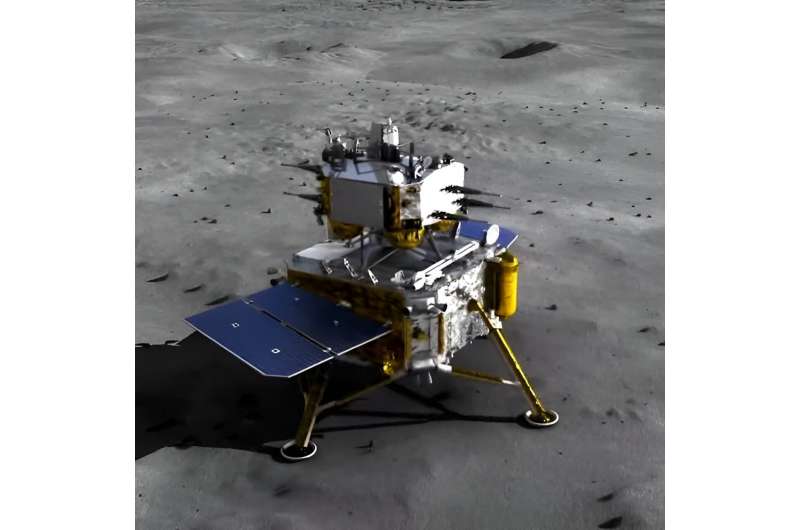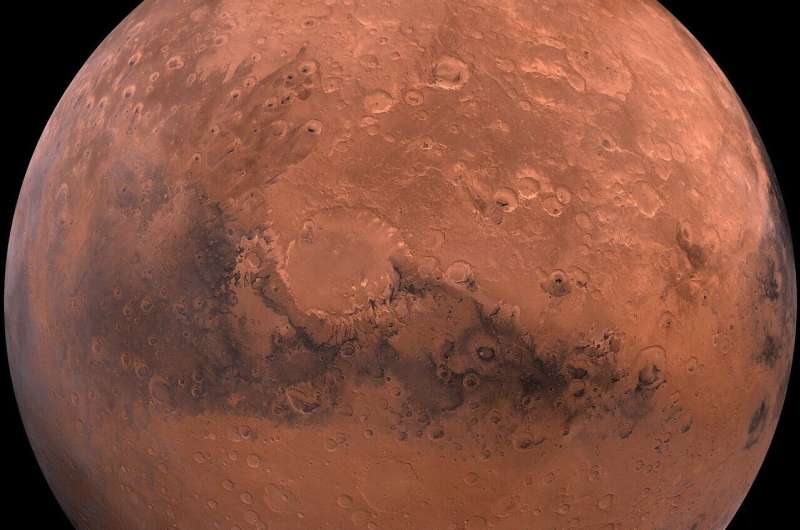
Copernical Team
China to launch first probe to return samples from Moon's far side
 China is set Friday to launch a probe to collect samples from the far side of the Moon, a world first as Beijing pushes ahead with an ambitious programme that aims to send a crewed lunar mission by 2030.
A rocket carrying the Chang'e-6 lunar probe is scheduled to blast off from the Wenchang Space Launch Center in southern China's Hainan province just before 5:30 pm (0930 GMT), officials have
China is set Friday to launch a probe to collect samples from the far side of the Moon, a world first as Beijing pushes ahead with an ambitious programme that aims to send a crewed lunar mission by 2030.
A rocket carrying the Chang'e-6 lunar probe is scheduled to blast off from the Wenchang Space Launch Center in southern China's Hainan province just before 5:30 pm (0930 GMT), officials have 'Baby asteroid' just a toddler in space years, researchers say
 An asteroid discovered last November is in fact a solar system toddler - just 2-3 million years old, a Cornell University-led research team estimates using novel statistical calculations.
The team derived the age of Selam, a "moonlet" circling the small asteroid Dinkinesh in the main asteroid belt between Mars and Jupiter, based only on dynamics, or how the pair moves in space. Their calcu
An asteroid discovered last November is in fact a solar system toddler - just 2-3 million years old, a Cornell University-led research team estimates using novel statistical calculations.
The team derived the age of Selam, a "moonlet" circling the small asteroid Dinkinesh in the main asteroid belt between Mars and Jupiter, based only on dynamics, or how the pair moves in space. Their calcu NASA Doubles Down, Advances 6 Innovative Tech Concepts to New Phase
 One of the 'science fiction-like' concepts - for a lunar railway system to provide payload transport on the Moon - is being developed at NASA's Jet Propulsion Laboratory.
NASA's Innovative Advanced Concepts program (NIAC) has selected six visionary concept studies for additional funding and development. Each study has already completed the initial NIAC phase, showing their futuristic ideas
One of the 'science fiction-like' concepts - for a lunar railway system to provide payload transport on the Moon - is being developed at NASA's Jet Propulsion Laboratory.
NASA's Innovative Advanced Concepts program (NIAC) has selected six visionary concept studies for additional funding and development. Each study has already completed the initial NIAC phase, showing their futuristic ideas Sidus Space fulfills order and supplies key components for NASA's Mobile Launcher 2
 Sidus Space (NASDAQ: SIDU), a Space and Data-as-a-Service satellite company, has successfully delivered two electronic LCS cabinets to Bechtel as part of NASA's mobile launcher 2 project. These cabinets are essential to the Launch Control System and signify a major milestone in Sidus Space's involvement in NASA's Artemis Campaign, which focuses on lunar exploration and colonization. Sidus Space
Sidus Space (NASDAQ: SIDU), a Space and Data-as-a-Service satellite company, has successfully delivered two electronic LCS cabinets to Bechtel as part of NASA's mobile launcher 2 project. These cabinets are essential to the Launch Control System and signify a major milestone in Sidus Space's involvement in NASA's Artemis Campaign, which focuses on lunar exploration and colonization. Sidus Space SpaceX successfully launches Maxar Intelligence next-gen satellites
 SpaceX successfully launched the Maxar 1 mission carrying two next-generation WorldView Legion satellites Thursday in California.
The mission launched from Vandenberg Space Force Base at approximately 11:36 a.m. local time. A SpaceX Falcon 9 rocket was used.
The 20th launch and landing of the Falcon 9 first stage was completed by 11:45 a.m. Pacific Time.
The two satellites
SpaceX successfully launched the Maxar 1 mission carrying two next-generation WorldView Legion satellites Thursday in California.
The mission launched from Vandenberg Space Force Base at approximately 11:36 a.m. local time. A SpaceX Falcon 9 rocket was used.
The 20th launch and landing of the Falcon 9 first stage was completed by 11:45 a.m. Pacific Time.
The two satellites Webb telescope's study suggests life on exoplanet remains unconfirmed
 Excitement was high when NASA's James Webb Space Telescope reported potential signs of life on a distant exoplanet. However, a new study by UC Riverside researchers published in the Astrophysical Journal Letters tempers these claims, discussing both the limitations and future possibilities of confirming life on such planets.
The research focuses on the exoplanet K2-18b, which in 2023 appea
Excitement was high when NASA's James Webb Space Telescope reported potential signs of life on a distant exoplanet. However, a new study by UC Riverside researchers published in the Astrophysical Journal Letters tempers these claims, discussing both the limitations and future possibilities of confirming life on such planets.
The research focuses on the exoplanet K2-18b, which in 2023 appea HyImpulse successfully launch their SR75 rocket from Southern Launch
 HyImpulse has successfully launched their SR75 rocket from the Koonibba Test Range, operated by Southern Launch, marking a significant step in Australia's commercial launch capabilities. The SR75, one of the largest rockets launched commercially in Australia, drew an audience of locals and VIPs from across Australia and Europe who witnessed the event on South Australia's Far West Coast.
HyImpulse has successfully launched their SR75 rocket from the Koonibba Test Range, operated by Southern Launch, marking a significant step in Australia's commercial launch capabilities. The SR75, one of the largest rockets launched commercially in Australia, drew an audience of locals and VIPs from across Australia and Europe who witnessed the event on South Australia's Far West Coast. ESA’s cloud and aerosol satellite aerosol-free

A few weeks ago, a team of engineers carefully extracted ESA's EarthCARE satellite from its protective transport container, initiating a meticulous process of inspection, testing and preparation for its liftoff later this month from the Vandenberg launch site in California.
Amidst an extensive checklist of tasks, was a rigorous effort to guarantee that the satellite is in pristine condition, underscoring the thorough attention to detail essential to making the satellite ready for launch.
China set to blast off to the far side of the moon—here's what it could discover

China is attempting to recover the first ever soil and rock samples from the lunar far side. The surface mission, Chang'e 6, named after the Chinese moon goddess Chang'e, is a successor to the successful sample return mission, Chang'e 5, and a part of the Chinese lunar exploration program.
The mission is set for launch using a long March 5 rocket at the Wenchang satellite launch center in Hainan province on May 3. The spacecraft due to land on the moon is projected to weigh 3,200kg carrying scientific equipment from France, Italy and the European Space Agency.
Chang'e 5 was the first lunar sample-return mission since the Soviet Union's Luna 24 in 1976. Chang'e 5 was hugely successful, returning 2kg of material from the near side. This material led to important scientific discoveries, such as the youngest lunar material ever discovered. Previously we only had much older samples returned from the Apollo missions and sampled meteorites.
Pulsed plasma rocket (PPR): Shielded, fast transits for humans to Mars

The future of a space-faring civilization will depend on the ability to move both cargo and humans efficiently and rapidly. Due to the extremely large distances that are involved in space travel, the spacecraft must reach high velocities for reasonable mission transit times. Thus, a propulsion system that produces a high thrust with a high specific impulse is essential. However, no such technologies are currently available.
Howe Industries is currently developing a propulsion system that may generate up to 100,000 N of thrust with a specific impulse (Isp) of 5,000 seconds. The Pulsed Plasma Rocket (PPR) is originally derived from the Pulsed Fission Fusion concept, but is smaller, simpler, and more affordable.
The exceptional performance of the PPR, combining high Isp and high thrust, holds the potential to revolutionize space exploration. The system's high efficiency allows for manned missions to Mars to be completed within a mere two months.
Alternatively, the PPR enables the transport of much heavier spacecraft that are equipped with shielding against Galactic Cosmic Rays, thereby reducing crew exposure to negligible levels. The system can also be used for other far range missions, such as those to the Asteroid Belt or even to the 550 AU location, where the sun's gravitational lens focuses can be considered.

